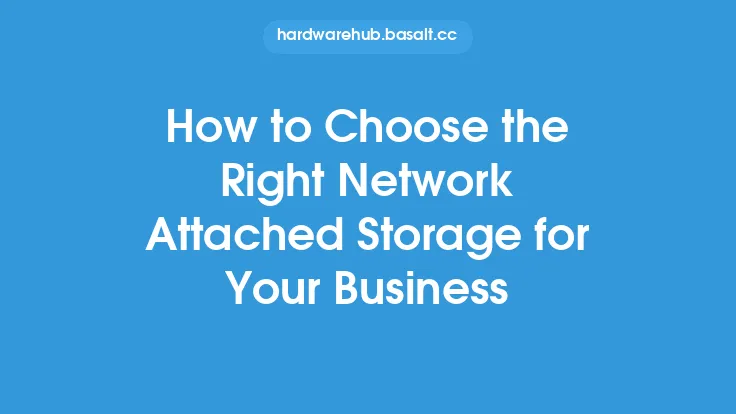When it comes to managing storage resources, organizations have a wide range of tools and technologies to choose from. With so many options available, selecting the right storage management tools can be a daunting task. The right tools can help optimize storage performance, reduce costs, and improve overall efficiency, while the wrong tools can lead to wasted resources, decreased productivity, and increased risk of data loss. In this article, we will explore the key factors to consider when choosing storage management tools for your organization.
Key Considerations for Storage Management Tools
Before selecting storage management tools, it's essential to consider several key factors. These include the type and size of your storage infrastructure, the level of complexity and scalability required, and the specific needs and goals of your organization. You should also consider the compatibility of the tools with your existing infrastructure and the level of support and maintenance required. Additionally, you should evaluate the tools' ability to provide real-time monitoring and reporting, automate tasks and workflows, and integrate with other management systems and tools.
Types of Storage Management Tools
There are several types of storage management tools available, each designed to address specific needs and challenges. These include storage resource management (SRM) tools, which provide a centralized view of storage resources and help optimize storage capacity and performance. Storage area network (SAN) management tools are designed to manage and optimize SAN infrastructure, while network-attached storage (NAS) management tools are used to manage and optimize NAS devices. Other types of storage management tools include cloud storage management tools, object storage management tools, and hyper-converged infrastructure (HCI) management tools.
Features and Functionalities to Look for
When evaluating storage management tools, there are several features and functionalities to look for. These include real-time monitoring and reporting, which provide visibility into storage performance and capacity. Automation and orchestration capabilities can help streamline tasks and workflows, while integration with other management systems and tools can help provide a unified view of the IT environment. You should also look for tools that provide advanced analytics and reporting, as well as predictive analytics and forecasting. Other key features to consider include data protection and security, scalability and flexibility, and ease of use and deployment.
Evaluating Vendor Support and Maintenance
When selecting storage management tools, it's essential to evaluate the level of support and maintenance provided by the vendor. This includes the availability of technical support, training, and documentation, as well as the vendor's reputation for delivering high-quality products and services. You should also consider the vendor's roadmap for the product, including plans for future development and enhancement. Additionally, you should evaluate the vendor's commitment to security and compliance, as well as their ability to provide customized solutions and support.
Best Practices for Implementing Storage Management Tools
Once you have selected the right storage management tools for your organization, it's essential to follow best practices for implementation. This includes developing a clear understanding of your storage infrastructure and requirements, as well as defining specific goals and objectives for the implementation. You should also establish a project plan and timeline, including milestones and deliverables, and assemble a team with the necessary skills and expertise. Additionally, you should conduct thorough testing and quality assurance, as well as provide training and support for end-users.
Common Challenges and Pitfalls to Avoid
When implementing storage management tools, there are several common challenges and pitfalls to avoid. These include inadequate planning and preparation, which can lead to delays and cost overruns. Insufficient training and support can also lead to user adoption issues and decreased productivity. Additionally, you should avoid selecting tools that are not scalable or flexible enough to meet the needs of your organization, as well as tools that do not provide adequate security and compliance features. Other common pitfalls to avoid include failing to monitor and report on storage performance and capacity, as well as neglecting to update and maintain the tools over time.
Future Directions and Trends in Storage Management
The storage management landscape is constantly evolving, with new technologies and trends emerging all the time. Some of the key future directions and trends in storage management include the increasing use of cloud and hybrid cloud storage, as well as the adoption of artificial intelligence (AI) and machine learning (ML) for storage management. Other trends include the growing importance of data protection and security, as well as the need for greater scalability and flexibility in storage infrastructure. As storage management tools continue to evolve, it's essential to stay up-to-date with the latest developments and advancements in order to optimize storage performance and efficiency.
Conclusion
Choosing the right storage management tools for your organization is a critical decision that can have a significant impact on storage performance, efficiency, and overall IT operations. By considering key factors such as storage infrastructure, complexity, and scalability, and evaluating features and functionalities such as real-time monitoring and reporting, automation, and integration, you can select the tools that best meet the needs of your organization. Additionally, by following best practices for implementation, avoiding common challenges and pitfalls, and staying up-to-date with the latest trends and developments, you can ensure that your storage management tools provide maximum value and return on investment.





